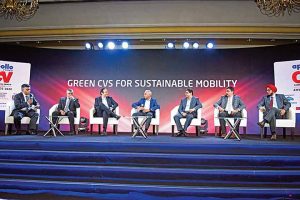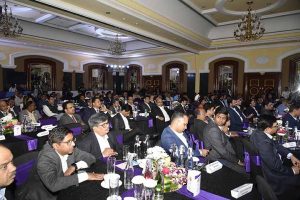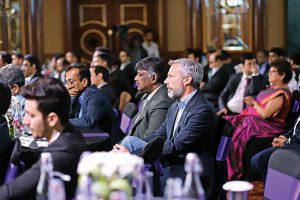CV industry leaders and consultants spoke about addressing various structural and cyclical challenges against the growing prospect of green CVs for sustainable mobility.
Panellists (l to R)
Kaushik Madhavan, Vice President – Mobility, Frost & Sullivan
Anuj Kathuria, COO, Ashok Leyland
Satish Sharma, President – APMEA, Apollo Tyres
Girish Wagh, President – Commercial Vehicles Business Unit, Tata Motors
Dr Venkat Srinivas, Vice President & Head, Engineering & Product Development, Mahindra & Mahindra Ltd., (Truck & Bus Division)
R S Sachdeva, COO and Head – R&D, VE Commercial Vehicles Ltd.
Moderator
VG Ramakrishnan, Managing Director, Avanteum Advisors
Pointing at developments like the new axle norms, the jump from BSIV to BSVI and the collapse of one of the biggest NBFC firms that lead to a liquidity crunch, Satish Sharma mentioned at the current slowdown in CV sales is on the back of a severe regulatory framework. Setting the tone for the panel discussion, he averred that the rising intensity of the slowdown has forced every stakeholder of the CV industry to bring the best to the table. Announcing that the CV industry is cyclical in nature, Girish Wagh averred that the CV industry is closely linked with the country’s GDP. Experiencing a secular growth trend, Wagh said that every trough and crest the industry has experienced has got bigger and longer over the last thirty years. Stating that the industry has at times taken six to eight months or 24 to 30 months to bounce back, Girish explained that the current slowdown is made unique by the combination of cyclical and non-cyclical factors. The cyclical factors were the slowdown in consumption and the slowing down of the rural economy as well as the infrastructural spending after the election, he explained. The non-cyclical factors, averred Girish, were the liquidity crunch and the new axle norms.
Of the opinion that the current slowdown is different from all the other slowdowns, Wagh expressed that it has been difficult to judge the increase in the vehicle parc. Whether it is 15 to 20 per cent or more. Informing that M&HCV sales have gone down by 45 to 50 per cent, Girish said that there could be some more months before the slowdown fades. Pointing at the transition to BSVI, he added that the impact of norms proved hard to judge during the third and fourth quarter of last year, expressed Anuj Kathuria that de-growth of 45 per cent hurt (the industry) badly. The gap between what the expectation was, and what really happened was large, he added. Stating the need to stop counting one vehicle as one, Kathuria mentioned, “The way the product mix is changing and the segmental shifts are happening, it is essential that the industry stops measuring one vehicle as one.” Drawing attention to multi-axle CVs, Anuj said that five sub-segments have come up in the M&HCV category. Stating that all the sub-segments have de-grown at different rates, Kathuria averred that the ICVs and LCVs have de-grown the least. “The LCVs have de-grown by 10 per cent and the ICVs have de-grown by 20 per cent,“ he added. Of the opinion that the hub and spoke model continues to progress, Anuj mentioned that the most de-growth has taken place in multi-axle vehicles and tractors.
Announcing that a new normal has set in by pointing at the surplus capacity created, Anuj Kathuria described that the underlying factors include improvement in turnaround time of vehicles, improvement in productivity on the back of better reliability, and improvement in utilization due to load aggregation. Of the opinion that new infrastructural projects will drive growth in tippers, Kathuria expressed that it won’t be right to expect much activity to happen in the two quarters after BSVI. “The peak that we saw in FY19 will not recur for at least one decade,“ said Kathuria.
Stating that many changes in technology are taking place rapidly (and concurrently) in view of energy transformation, Dr Venkat Srinivas averred that there were plenty of challenges including the need for suppliers to gear up. Explaining that a lot of play in the area of electric CVs is taking place, he mentioned much needs to be realized. Of the opinion that progress under schemes like FAME has not been as much as anticipated, Dr Srinivas explained that it is not just about the battery cost coming down, but about growth in charging infrastructure as well. Explaining that there is an opportunity in urban mobility for electric CVs, Dr Srinivas expressed that LCVs could also find acceptance in an electric form. Informing that other electric CV concepts in the people movement space could be had, in the last-mile connectivity space especially, he stated that cleaner mediums like LNG could find a way in heavier CVs. Such mediums come with their own ecosystem and challenges, Dr Srinivas remarked. Revealing that the significant torque requirements associated with tippers make it different as far as electric technology is concerned, he said that an amount of experimentation was necessary to make it viable. Calling upon the need for a long-term framework, he expressed a need for consortium approach and the setting up of guidelines. Stressing on the need to move in a specific direction rather than the current situation, which looks chaotic, Dr Srinivas averred that they have vehicles running with type-four cylinders. He explained that the regulatory framework in India took long to fall in place.
Of the opinion that energy transformation in Europe is technology agnostic and devoid of any dictation, Dr R S Sachdeva mentioned that the focus is very clearly on greenhouse gas reduction. It is 15 per cent by 2025 and 30 per cent in 2030, he added. Stating that there’s a talk of 20 per cent reduction by 2027 in North America, Dr Sachdeva touched on the freedom companies have there to try out new technologies as long as they contribute to the guidelines of greenhouse reduction. Expressing that such a move in India will bring results, he drew attention to BSVI compliance in a span shorter than in Europe. Calling for a clear road map, Dr Sachdeva said that a lot of work was being carried out in the area by Niti Aayog, by the power sector, and by the petroleum and gas industry. He informed that in the last thirty years the carbon footprint in India has reduced by 20 per cent. A 90 to 95 per cent reduction in NOx was achieved, he expressed. Explaining that the complete carbonization roadmap for India is slated at 2050 according to experts, Dr Sachdeva stressed on the need to promote alternate fuels like LNG and CNG; to promote hybrid (made unviable in India by imposing a 42 per cent duty) as an intermediate solution, and to promote electric vehicles as well as hydrogen fuel cell-based electric vehicles. Pointing at CNG and LNG as a low hanging fruit, he revealed that the acquisition cost of CNG is coming down to four to five per cent as compared to 17 to 18 per cent in the wake of BSVI. Informing that the operating cost of CNG is less because the cost of CNG per kg is 35 per cent less than the diesel price, Dr Sachdeva drxpressing that the current slowdown the CV industry is against the backdrop of a severe regulatory framework, Satish Sharma stressed upon attention to 1300 CNG fuel stations that currently exist. Stressing on the government’s announcement to install another 10000 CNG fuel stations by 2030, Dr R S Sachdeva mentioned that 23 per cent reduction in carbon could be achieved by opting for CNG or LNG. He opined that clarity could be sought by following a roadmap where CNG is for short-haul and LNG is for the long-haul. Stating that the next step would be to look at hybrids and electrics, Dr Sachdeva said that battery vehicles have come to run successfully. Drawing attention to the Indian Government’s to move away from an oil-based economy to a gas based economy, Wagh cited reports mentioning the conversion of 35 per cent of LCVs in developed markets to alternate fuels including electricity by 2030. He added that the transition in India would lead to CNG as the first step. Of the opinion that 25 per cent of medium CVs will move to alternate fuels like LNG and CNG, Wagh said that a few OEMs are already close to commercializing fuel cell technology. Stressing on it being the right technology for CVs as it does not suffer from range anxiety, he drew attention to the technology agnostic approach Tata Motors has been taking. Informing that the company’s early participation in the area of battery electric helped it to bag 50 per cent of FAME I, Wagh averred, “Not only has Tata Motors been aggressive in FAME II, it is also working on hydrogen fuel cell technology.” Stating that such efforts would entail an amount of collaboration, Wagh expressed that government incentives will drive the market. Stressing upon TCO parity, he opined that there is a need to look at a basket of alternative fuel solutions.
Stressing on the need to look at the entire lifecycle as service based revenues will rise, Kaushik Madhavan cited the example of tyres and described their management as a service. He averred, that there is a need to look at the energy side of CVs as well as their entire lifecycle. Of the opinion that electric vehicle technology will continue to evolve, Kathuria said that the way forward would enter into partnerships. He drew attention to the steep fall in EV sales in China after the government there reduced incentives. Calling for a need to keep experimenting until the right technology is found, Kathuria mentioned that in the absence of ROI guarantee, the best way would be to collaborate, to work as a consortium, and to invest jointly. Informing that radialisation of tyres in heavier CVs has risen to 70 per cent, Sharma called for the need to move from tube-type radial tyres to tubeless radial tyres. This, he added, would ensure more air to support higher payload. Citing the example of tyre labels in passenger vehicle tyres, and how they are defining the efficiency value as well as noise, Sharma said, “Noise is very important when it comes to electric vehicles.”
Emphasising on the need to have a roadmap and to address the infrastructural challenges, Sharma said that progress in the area of green vehicles is only going to accelerate further. He informed that air pressure is at the heart of the tyres and TPMS would be the next step. Of the opinion that TPMS will help to capture the data points and fuel the next evolution, Sharma mentioned, “A simple procedure of rotating the tyres in a certain stipulated sequence would lead to an increase in performance by 20 to 25 per cent.” Stating that fleets are looking at outsourcing tyre management, Sharma expressed that tyres from a product standpoint will soon progress to a service standpoint. Referring to TMPS as a well-proven technology, Dr Srinivas averred that the challenge was in monetizing it. Stressing on the need to prove the benefit of such technologies through data, he added that aggregators are well-placed to play an important role. Expressed Dr Sachdeva that diminishing buying capacity in the wake of the slowdown is getting customers to demand a frugal vehicle with bare minimum features.
Of the opinion that the fuel efficiency of fossil fuel-powered CVs could be improved by five to 10 per cent by reducing the rolling resistance of tyres, Dr Sachdeva averred that the charge efficiency of EVs could be improved by five to seven per cent. He informed that efforts were being taken by the OEMs are to reduce the TCO without adding costs. Emphasised Anuj Kathuria that positive growth will soon return to the Indian CV industry. He also opined that freight rates will move up. Revealing that they are educating customers about TCO rather than worry about the initial acquisition cost, Kathuria said that a collaborative approach would ensure customer benefits. Stressing on the need to deliver the right value to the transporters, Kathuria explained that a big change in the reckoning is the move from being a B2B oriented industry to a B2C oriented one. Indicating the rising trend where service providers like tyre manufacturers start collaborating with aggregators to ensure higher value, Kathuria touched on the prospect of large third party companies as asset owners. Such companies would lease the asset to their customers to help them met their demand, he said. Stressing on lifecycle management rather than the acquisition cost, Kathuria said that the picture will be clear soo. Averred Girish Wagh that the economy is growing, and a billion tonnes per kilometre equation will continue to grow. He informed that it grown by five per cent this year. Stating that aggregators have been winning the business by dropping rates, Wagh said that there is good scope for improvement in TCO yet. Acknowledging the fact that the behaviour of the aggregators whose bottom line is not healthy has put pressure on established players in the transport industry, he pointed at a potential to control other costs of the transporter that are going up. Emphasizing on improving fleet utilization further, Wagh expressed the need to enhance the time taken to load and unload. Stressing the need to reduce idling time of CVs, he touched on the logistics cost in India in connection with the GDP. It is 13 to 14 per cent when compared to the cost in Europe or US, which is six to eight per cent, revealed Wagh. Mentioning that 70 per cent of the CV industry in such markets continues to be retail in nature despite the presence of various business models including leasing, Wagh opined that consolidation will happen at the top whereas the retail customer will continue to occupy roughly 70 per cent of the market. Stating that the job of CV OEMs will be to improve the profit and loss statement of topline customers and help the retail customers to link to market load such that their TCO rises, Girish said that growth will return to the CV industry . Concluded Satish Sharma that higher efficiency will have to be brought in as there is still an amount of TCO on the table for the asking.






















